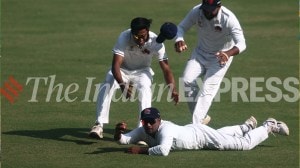In big brother’s shadow
I am now resigned to the fact. Flaunting one's millions is the norm of this age, and a walk through the lanes of my neighbourhood in Delhi c...

I am now resigned to the fact. Flaunting one’s millions is the norm of this age, and a walk through the lanes of my neighbourhood in Delhi confirms it to me every day. What with the exterior of every house — sometimes belying the much more humble and unaesthetically subdivided and poorly maintained much-rented-out interior — vying with that of the next in the flashiest possible use of highly inappropriate material, the deep, human need for visibility is painfully obvious.
But in this bustling colony of "residential" buildings and "residential" lanes, choked to the hilt with multicoloured Marutis, the eye is barely allowed the full perspective required for reflection upon any one particular building style. Despite that, each clamours for eye-contact with the harassed walker of an evening, by the most obvious posturings, the most touching remonstrances.
There are a few houses that should, indeed, show the loving thought and painstaking effort that had gone into their design. The trouble is that they standliterally overshadowed by the multi-storeyed apartments that seem to spring up in the place of each painstakingly built house that had the temerity to remain single-storeyed, obviously betraying the failure of tottering incomes to cope with galloping prices.
Every other day sees the departure of a good neighbour and dear friend who was tempted to give in to selling his blood and sweat to a builder, and one braces oneself for the demolition of another familiar little house that will give way to another one of those uniformly designed grey-cemented (or these days "Dholpur-stoned") set of multi-storeyed apartments that will put paid to the privacy of ground-floor dwellers.
Of course, over the years, one has gotten used to Punjabi baroque and butter-chicken rococo. Nevertheless, there is one house that causes a perceptible sinking of the heart every time I pass it by. And it is no monstrous apartment complex. It has been built by two brothers, and so blatantly does it advertise the disparities in theirstandards of living that I find myself drawn to stare at it with unashamed incredulity every time I fail to avert my gaze in time.
This ancestral property has been ingeniously halved with a vertical demarcation that allows rights to half the ground floor and half the terrace to both parties. The two juxtaposed halves, which were once a single unit, invite some pondering, attested to by the curious glances of passersby.
The financially upwardly mobile graph of one brother is forcibly made visible in his half of the building, extending to two-and-a-half storeys, which are plated all the way up with a curious combination of grey and white marble slabs, ominously overpowering in its tastelessness. The other half (that of the struggling brother) is dramatically halted after a single storey, behumbled further by the obviously desperate want of a fresh coat of paint, the crumbling cement and the small rusted gate. His home stands like a poor dwarf-brother trying embarrassedly to dig itself into the earth, in theshadow of its menacingly opulent big brother.
I was tempted to ask about the professions of the owners of the two incongruous halves, who have been forced to cohabit in one plot by the strange hand of fate — by birth in the same family. It transpired that both the brothers are engineers with the Delhi Development Authority!
As I turn my gaze from the oppressive two-and-a-half storeyed half to the one digging its heels into the ground, I feel there is yet hope for my country, visible in that rusted gate, that crumbling facade. The metaphor may lie in a single storey, but the foundations of honesty run deep.



- 01
- 02
- 03
- 04
- 05




























